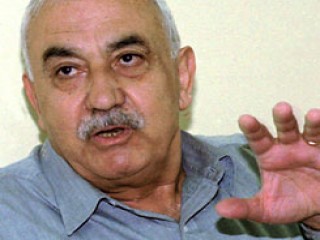
George Habash biography
Date of birth : 1926-08-02
Date of death : -
Birthplace : Lydda, British Mandate of Palestine
Nationality : Palestinian
Category : Politics
Last modified : 2011-05-11
Credited as : Activist, al-hakim, founder of the Arab Nationalists' Movement, PLO
George Habash was a founder of the Arab Nationalists' Movement in 1952 and of the Popular Front for the Liberation of Palestine (PFLP) in 1967.
George Habash was born in Lydda in 1926 to a family of Christian Palestinian merchants. When Arab-Jewish fighting broke out in Palestine in 1948, he was a medical student at the American University of Beirut in Lebanon. He returned home to Lydda to try to help his community, but was forcibly expelled from Lydda by the advancing Jewish forces.
Like others in Palestine and the Arab states, Habash was embittered by the Arabs' defeat in 1948 and sought a way to redeem Arab honor. In 1950, back at his classes in Beirut, he joined with other students from many different Arab countries to form the Arab Nationalists' Movement (ANM). The ANM preached that only the unified actions of all the Arab people could liberate the Arab world, including Palestine. Because the movement rejected the Islamic fundamentalism then rife in the Arab world, it attracted much support from the minority of Arabs who were Christians. It also rejected such socially divisive ideologies as socialism and communism, as well as the splitting up of the Arab world into separate states.
During the 1950s Habash had criticized Yasser (or Yasir) Arafat's Fateh (also transliterated as Fatah) organization and other Palestinians who were guilty of what the ANM considered to be "Palestinian separatism" from the pan-Arab cause. It was not until 1964 that the ANM started doing systematic political work in the Palestinian community.
Many of the ANM's ideas and aims were shared by Gamal Abdel-Nasser, who came to power in Egypt in 1952. From 1954 through 1967, the ANM worked closely with Nasser, pursuing their joint aims throughout the Arab world. In 1967, however, Nasser was humiliated by his country's defeat in the Six Day War with Israel, so Habash and his colleagues started rethinking their alliance with him.
The shock of the 1967 defeat caused the ANM's leaders to rethink some of their other ideas, too. In December 1967 the ANM decided to found its own Palestinian organization, which it called the Popular Front for the Liberation of Palestine (PFLP). Habash became its general secretary.
The PFLP was always smaller than Fateh. At the beginning the PFLP's leaders considered that the only way they could compete with Fateh for popular attention was to stage large-scale terrorist operations against Israeli and pro-Israeli targets. The most spectacular of these was the hijacking of four Western airliners to a desert airstrip in Jordan in September 1970. This action gave the Jordanian government the opportunity to crack down on the Palestinian guerrillas who then moved to Syria.
Shortly thereafter the PFLP sought inclusion in the Fateh-dominated Palestinian Liberation Organization (PLO). At some stage in the early 1970s Habash's official PFLP leadership disavowed the terrorist operations that were still being carried out by PFLP extremists. But the PFLP maintained its hard-line political stance. In 1974 it vehemently opposed the PLO mainstream's shift toward calling for the establishment of a Palestinian state in just part of historic Palestine and formed a new alliance of PLO oppositionists called the "Rejection Front."
In 1978 the Rejection Front was dissolved, as Palestinian nationalists united their ranks in opposition to the Egyptian-Israeli peace process. Five years later, however, it was the PLO's Fateh-based leadership which was seeking a peaceful settlement with Israel, and once again the PFLP moved to the opposition. In 1984 the PFLP and the Democratic Front for the Liberation of Palestine (DFLP) formed the backbone of a new coalition of Palestinian hardliners called the Democratic Alliance.
Since his rejection of Arafat's (PLO) plan for peace with Israel and the establishment of a Palestinian Arab State, Habash moved his headquarters to Damascus, Syria, where his PFLP was tolerated by Syrian leader, Hafes Assad. Habash continued to deny Arafat's leadership and opposed peaceful co-existence with Israel—although he agreed to accept the Palestine National Council's decisions.
Habash was known to Palestinians as al-hakim (the Doctor). Possessed of a high degree of charisma, he kept the PFLP intact through many internal schisms and failed alliances. In the late 1960s he had announced his conversion from pure nationalism to Marxism, and he maintained some relations with the Soviets after the early 1970s. He was married and had two daughters. In 1980 he suffered a stroke, which left him partially paralyzed. While he was undergoing treatment for the stroke, the PFLP suffered massive internal faction-fights, but his return to the helm apparently restored some stability.
The partial paralysis resulting from his 1980 stroke moderated Habash's political fervor and limited his influence within the PFLP and on Arab politics in general. The silver-haired Habash, however, still posed a threat to peace in the Middle East. In the mid-1990s, he travelled to Libya to confer with Muammar Qadhefi, while Naef Hawatmeh, leader of the DFLP, flew to Iraq for a meeting with Saddam Hussein. Both national leaders alledgedly support and finance terrorism, including high-tech weaponry and terrorist training camps. As the political climate in Syria changes, Habash could be planning to move the PFLP headquarters to Iraq.
















